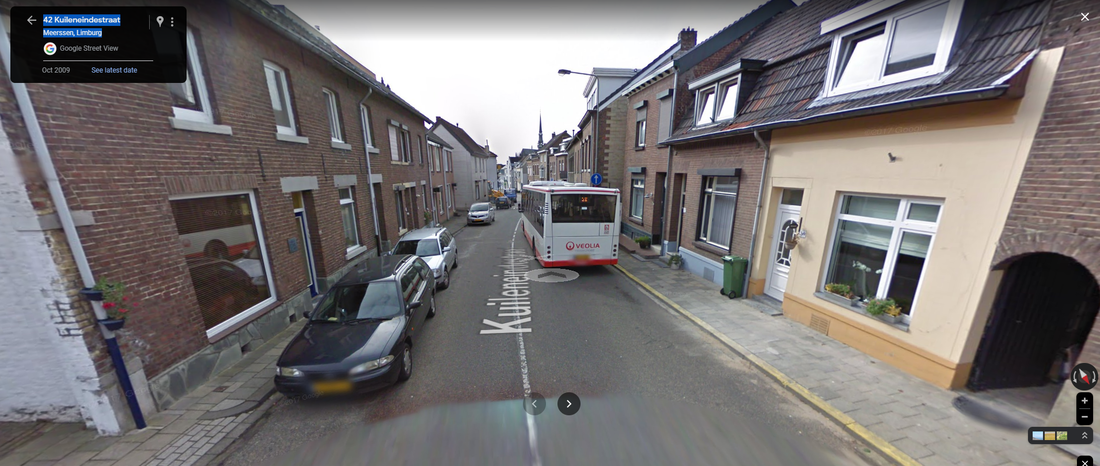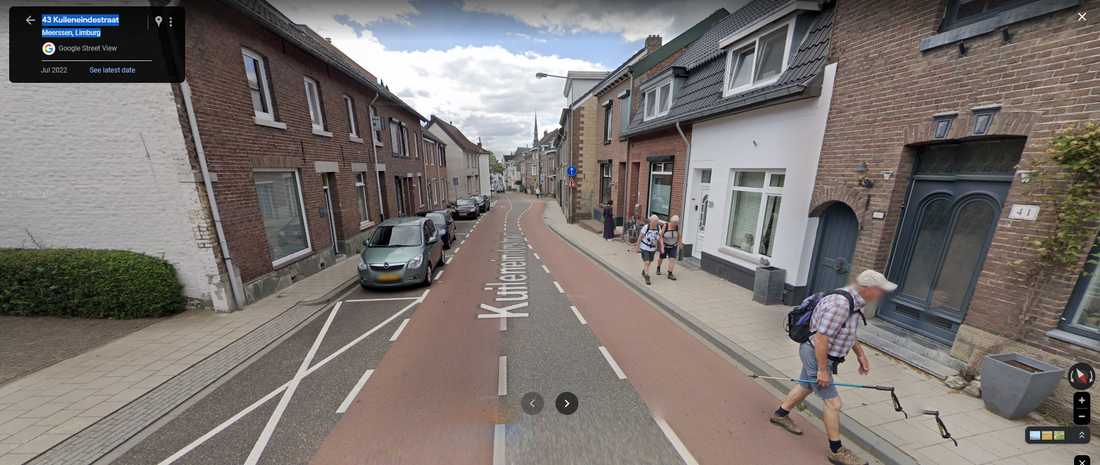Introduction
An edge lane road, or ELR, is a shared street treatment that provides for two-way motor vehicle and vulnerable road user (VRU) traffic using a center lane and edge lanes on either side. The center lane is primarily for motorists traveling in both directions but VRUs can use it also. VRUs such as cyclists or pedestrians have right-of-way in the edge lanes but motorists can use the edge lanes, after yielding to the VRUs there, to pass approaching vehicles. This can sound ludicrous to those not familiar with the concept but it works well in numerous countries, including the US and Canada. This roadway configuration originated in the Netherlands where they have over 50 years and many hundreds of road-kilometers of experience with this facility.
The video below was produced by the City of Ottawa and is a good explanation of how this shared street treatment operates.
An edge lane road, or ELR, is a shared street treatment that provides for two-way motor vehicle and vulnerable road user (VRU) traffic using a center lane and edge lanes on either side. The center lane is primarily for motorists traveling in both directions but VRUs can use it also. VRUs such as cyclists or pedestrians have right-of-way in the edge lanes but motorists can use the edge lanes, after yielding to the VRUs there, to pass approaching vehicles. This can sound ludicrous to those not familiar with the concept but it works well in numerous countries, including the US and Canada. This roadway configuration originated in the Netherlands where they have over 50 years and many hundreds of road-kilometers of experience with this facility.
The video below was produced by the City of Ottawa and is a good explanation of how this shared street treatment operates.
Terminology
This treatment is known by different names. Examples include: 2-minus-1 roads (New Zealand, Denmark), Edge Lane Road (Denmark, US), Schutzstreifen (Germany), Suggestiestrook (Netherlands), and Advisory Bike Lanes (US).
I recommend the use of "Edge Lane Road" or ELR since it avoids the numerous problems associated with the Advisory Bike Lanes and Advisory Shoulders names. Those problems are described here.
This treatment is known by different names. Examples include: 2-minus-1 roads (New Zealand, Denmark), Edge Lane Road (Denmark, US), Schutzstreifen (Germany), Suggestiestrook (Netherlands), and Advisory Bike Lanes (US).
I recommend the use of "Edge Lane Road" or ELR since it avoids the numerous problems associated with the Advisory Bike Lanes and Advisory Shoulders names. Those problems are described here.
Purpose
This website has two goals around ELRs: 1) ensure accurate information is available to everybody and 2) put a stake in the ground on design issues with an intent to foster dialogue. This site targets traffic engineers, bicycle advocates and those that are more knowledgeable about road design.
This website has two goals around ELRs: 1) ensure accurate information is available to everybody and 2) put a stake in the ground on design issues with an intent to foster dialogue. This site targets traffic engineers, bicycle advocates and those that are more knowledgeable about road design.
New Videos documenting experiences with ELRs from Vail, CO and Yarmouth, ME!
Two new videos have been released as of April 24, 24. They document the story of ELRs in two communities - Vail, CO and Yarmouth, ME. They feature town leaders, law enforcement, advocates, and citizens that simply like to walk. Click here to access the videos.
Two new videos have been released as of April 24, 24. They document the story of ELRs in two communities - Vail, CO and Yarmouth, ME. They feature town leaders, law enforcement, advocates, and citizens that simply like to walk. Click here to access the videos.
ELRs are Shared Roadways
ELRs are a shared street paradigm rather than a new type of bike lane. The concept of a shared roadway exists in the MUTCD. A process for implementing an ELR in compliance with the 2009 MUTCD is described here.
ELRs are a shared street paradigm rather than a new type of bike lane. The concept of a shared roadway exists in the MUTCD. A process for implementing an ELR in compliance with the 2009 MUTCD is described here.
Short Course on ELR Planning and Design
Because ELRs are new to the US and best practices are not well disseminated, many facilities exhibit missed opportunities to increase safety or comfort. If you don't have time to read the design guide, the following two documents should help you avoid the most common missteps.
Seven ELR Planning Sins
Seven ELR Design Sins
Because ELRs are new to the US and best practices are not well disseminated, many facilities exhibit missed opportunities to increase safety or comfort. If you don't have time to read the design guide, the following two documents should help you avoid the most common missteps.
Seven ELR Planning Sins
Seven ELR Design Sins
ELRs Where Vulnerable Road User Safety is the Priority
In the US, many folks are express concern about drivers' ability to handle ELRs. This is a red herring.
What would result if VRU safety was the primary concern?
Kuileneindestraat is a street in Meerssen, Limburg in the Netherlands that used to be 2-lane (photo on left). They installed an ELR in 2019 (photo on right). They kept the edge lanes wide to accommodate VRUs despite the street being too narrow for a one-vehicle-wide center lane.
This is the result of making VRU safety a priority. FYI This is not the only street in the NL that looks like this.
I neither recommend nor oppose this design in North America; I don't know how it would perform with unfamiliar drivers. It would be interesting to see a pilot.
In the US, many folks are express concern about drivers' ability to handle ELRs. This is a red herring.
What would result if VRU safety was the primary concern?
Kuileneindestraat is a street in Meerssen, Limburg in the Netherlands that used to be 2-lane (photo on left). They installed an ELR in 2019 (photo on right). They kept the edge lanes wide to accommodate VRUs despite the street being too narrow for a one-vehicle-wide center lane.
This is the result of making VRU safety a priority. FYI This is not the only street in the NL that looks like this.
I neither recommend nor oppose this design in North America; I don't know how it would perform with unfamiliar drivers. It would be interesting to see a pilot.
News
Accessible Design for the Blind (ADB), best known as the entity led by tireless advocate for the low vision population, Janet Barlow, released a letter in September 2022 stating their preference for ELRs over standard 2 lane roads without sidewalks for the low vision population. A copy of the letter is available here.
A draft proposal by the NCUTCD Bicycle Technical Committee on an MUTCD addition for ELRs as advisory bike lanes has been completed and is out for review by other technical committees. The Pedestrian Joint Task Force is working on a proposal for ELRs that support all types of vulnerable road users. Whether these 2 proposals will be combined or kept separate is unknown.
Nobody knows when the new AASHTO Bicycle Guide will be released. We do know that it includes some new guidance on the treatment. The AASHTO draft copies the Dutch guidance on on center lane width which should help create safer facilities. Unfortunately, it keeps Passing Sight Distance as the sight distance criterion.
Accessible Design for the Blind (ADB), best known as the entity led by tireless advocate for the low vision population, Janet Barlow, released a letter in September 2022 stating their preference for ELRs over standard 2 lane roads without sidewalks for the low vision population. A copy of the letter is available here.
A draft proposal by the NCUTCD Bicycle Technical Committee on an MUTCD addition for ELRs as advisory bike lanes has been completed and is out for review by other technical committees. The Pedestrian Joint Task Force is working on a proposal for ELRs that support all types of vulnerable road users. Whether these 2 proposals will be combined or kept separate is unknown.
Nobody knows when the new AASHTO Bicycle Guide will be released. We do know that it includes some new guidance on the treatment. The AASHTO draft copies the Dutch guidance on on center lane width which should help create safer facilities. Unfortunately, it keeps Passing Sight Distance as the sight distance criterion.
Latest Research
A 2021 study from the Mineta Transportation Institute found an aggregate CMF value of .56 using Empirical Bayes analysis for 11 U.S. installations studied over 8 years and approximately 60 million motor vehicle trips. This corresponds to a crash rate reduction of 44%. Only motor vehicle crashes were studied. There was insufficient data to evaluate vulnerable road user safety but no agency reported a bicyclist or pedestrian safety issue with their ELRs.
The report is available at “Safety Considerations for All Road Users on Edge Lane Roads”.
A new analysis of the Mineta data using even more conservative assumptions was recently published in the Journal of Transportation Engineering published by the American Society of Civil Engineers (ASCE); it found a crash rate reduction of 36% or a CMF of .64. That article is available here.
Keep up-to-date on ELR news
An email-based listserve has been created to support discussion of ELRs. You can join by sending an email with "subscribe" in the subject line to [email protected].
A 2021 study from the Mineta Transportation Institute found an aggregate CMF value of .56 using Empirical Bayes analysis for 11 U.S. installations studied over 8 years and approximately 60 million motor vehicle trips. This corresponds to a crash rate reduction of 44%. Only motor vehicle crashes were studied. There was insufficient data to evaluate vulnerable road user safety but no agency reported a bicyclist or pedestrian safety issue with their ELRs.
The report is available at “Safety Considerations for All Road Users on Edge Lane Roads”.
A new analysis of the Mineta data using even more conservative assumptions was recently published in the Journal of Transportation Engineering published by the American Society of Civil Engineers (ASCE); it found a crash rate reduction of 36% or a CMF of .64. That article is available here.
Keep up-to-date on ELR news
An email-based listserve has been created to support discussion of ELRs. You can join by sending an email with "subscribe" in the subject line to [email protected].
Database of ELRs in North America
I maintain a database of ELR installs in the US and Canada (there are more than 80 as of July 2023!). The database includes geometric, technical, and legal information on each facility secured through an interview with an agency representative. I hope to make this data publicly available, ala Kittelson's roundabout database, in the future. If you are aware of a new ELR, please let me know by emailing me at [email protected].
I maintain a database of ELR installs in the US and Canada (there are more than 80 as of July 2023!). The database includes geometric, technical, and legal information on each facility secured through an interview with an agency representative. I hope to make this data publicly available, ala Kittelson's roundabout database, in the future. If you are aware of a new ELR, please let me know by emailing me at [email protected].
Advisory Bike Lanes |
Top Photo Courtesy of Richard Sparks
|

